
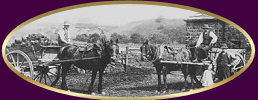
The History of Lunedale
The history of any place is the story of its people. Like most areas in the British Isles there are remains and reminders of human activity spanning the layers of time.
Prehistory
The distant echoes of pre-history remain in its stone circle and its chieftain's burial mound. Piace names remind us of the Saxon and Viking settlements and Norman hunting grounds.
Parchments begin the slowly accumulating record building through the centuries charting the changing fortunes of farming, quarrying and lead mining continuing through photography and print to the times of living memory within the last century, that which arguably saw the greatest pace of change.
Throughout, however, the people who lived here would have experienced the same range of emotions as we do today. They would have displayed the same positive character traits too of generosity, community-spirit, openness, honesty and possibly some less positive ones!
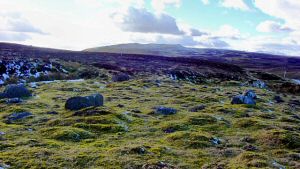 Wars, rebellion and unsettled times have affected not only twentieth century
'Lunedalers', but also throughout history there have been raids and skirmishes
much closer to home, though whether the people felt more or less frightened
by these than by stray WW2 bombers and fighter planes it is impossible to say.
Wars, rebellion and unsettled times have affected not only twentieth century
'Lunedalers', but also throughout history there have been raids and skirmishes
much closer to home, though whether the people felt more or less frightened
by these than by stray WW2 bombers and fighter planes it is impossible to say.
Lunedale was inhabited in prehistory. There is a stone circle near the roadside a mile or so from the current county boundary between Cumbria and Durham.
Kirk Carrion
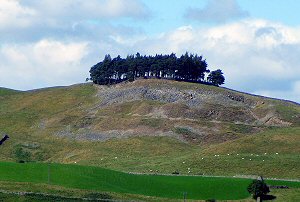 The
tumulus of Kirk Carrion (shown on 1856 OS map as Kirk Arran) is thought to be
the burial pSace of a chieftain named Caryn. In 1804, whilst stones were being
dug out of the tumulus for the enclosure of Crossthwaste pasture, Holwick, a
chamber ('kistvaen') was discovered. Four flat stones set up on edge formed
the chamber, and it was covered by a fifth. When it was opened there was a small
The
tumulus of Kirk Carrion (shown on 1856 OS map as Kirk Arran) is thought to be
the burial pSace of a chieftain named Caryn. In 1804, whilst stones were being
dug out of the tumulus for the enclosure of Crossthwaste pasture, Holwick, a
chamber ('kistvaen') was discovered. Four flat stones set up on edge formed
the chamber, and it was covered by a fifth. When it was opened there was a small
urn inside- The man who had found it, thinking he had discovered buried treasure
put his arms round it and shouted 'it's aa'll mine'. To his disappointment the
urn contained only fragments of bone and some dark matter.
Lord Strathmore's bailiff, Mr C Raine, of Lonton, marked the spot by planting the trees and the urn was sent to Streatlam Castle, at that time the home of the Bowes family.
According to the Reverend William Bell, a former Vicar of Laithkirk, it seems as though some great man, possibly a chief named Caryn had died either peacefully or as the result of a battle and his body had been burned on a funeral pyre. His ashes had been collected and placed in the urn and the 'kistvaen' created. Straightway his tribe would have covered it with stones and toiled night and day to raise the great heap or tumulus - Henceforth it would be known as Carreg Caryn i.e. the burial heap of Caryn.
Viking Times
The words for many of the natural features in the landscape as well as place-names and farming related terms are evidence of earlier settlement. Saxon words include; croft, toft, rig, and laith. Similarly there are very many examples of Viking names: kirk, garth, thrin, hoime, gill, Carl and beck.
Norman Conquest
In Medieval times this area formed part of the hunting grounds of the Fitzhugh family who owned lands and castles at Ravensworth and Cotherstone. Since the Norman Conquest all forested land had belonged to the king and his permission was required to hunt, even on your own domain. On 21st February 1201 King John 'granted Henry Fitz-hervey the services of Lonton and Thringarth with theForest of Loun (Lune) and Free Chase'. In other words he gave his permission for Henry Fitz-hervey to hunt here.
The prefix Fitz signifies 'son of' and therefore the names vary but eventually the family settled on the name Fitzhugh. The Fitzhughs built a small castle or hunting lodge in the valley below Laithkirk church. All that remains are a few stones gathered up by the Rev Bell and re-erected in his Laithkirk vicarage garden.
The forests were not densely packed with trees but were wild, open spaces,interspersed with thickets and bushes and trees. The names remain in the valley,an echo of the hunting ground: East and West Park, Lune Forest. With the coming of the Normans the English were deprived of taking wood from the forest. These became the sole preserve of the hunters and foresters who looked after the area. The peasants henceforth had to build their homes from stones they dug out of the fields.
Baron George Fitzhugh of Ravensworth died in 1512. He had no sons or daughters and his estates passed to his aunt, Lady Feinnes and his cousin, Thomas Parr. In 1532 Thomas Parr sold the lands at Mickleton, 'Loun' and Holwick to Mr Bowes of Streatlam.
In 1565 the daughter of Sir George Bowes married John Lyon, 9th Earl of Strathmore who added Bowes to his name and after his death the estate became known as the Strathmore Estate.
The Mickleton Lease
The Mickelton Lease was signed in 1607 and documents the history of Middleton manor from 1560 to 1600.
Read more about the lease.
West Park -1715
In 1715, Jack O'Lune was living at West Park, Lunedale and earning his living as a carter. He owned a team of ponies, or jaggers, and he carried goods for people as far afield as Newcastle and Appleby. In late October that year a rebellion against King George I was gaining strength and many rebels troops under the command of Northern and Scottish Lords were gathering and making their way south to Preston. They were taking a route from the Borders through Northumberland and then westward to Lancaster via Penrith and Appleby.
Jack was an honest and fearless man who was able to use this situation to his advantage by carrying to safety the valuables of the people In the Appleby area. Such work paid a good rate and Jack. hired his neighbour, Thornborrow from Stakehill to ride with him for added safety. On the night of 2nd November they were just about to fall asleep in their lodgings in Appleby when they were roused by the sounds of men running through the street shouting 'rebels, rebels'. Thornborrow leapt up and shouted 'Oh, Jack. we're done for now. We shall lose all our horses, even if we save our lives'. Jack merely responded "Lie still, man! We're all right yet. It's only a herd of idle lads, trying to scare the folks by raising a false alarm."
He had correctly calculated that the rebels could not be so close and they left early the next morning. They were safely back in Lunedale by the time the rebel vanguard was entering Appleby late that evening.
That wasn't the only example of his good judgement. Next time he was in Appleby he made enquiries about waifs and stray horses. He correctly predicted that many horses would have been rounded up after the skirmish and he bought a fine bred in-foal mare for a mere trifle from the pinder. The foal turned out to be a fine filly and in time became broken and trained, Jack won several prizes with her at Kyloe-green near Crossthwaite. A gentleman bought her for £6 10s. and she afterwards distinguished herself on many southern racecourses.
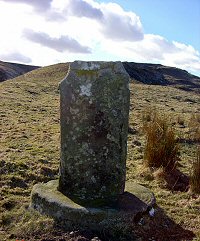 Others
in Lunedale have also tried to make use of whatever came to hand. One fellow,
in need of a gate stoop found what he thought was the ideal stone and promptly
removed it to build his gateway. His enraged landlord, Lord Strathmore, recognising
the said stone as the shaft of the ancient wayside cross from Cross Hill, Grains o'Beck, ordered him to take it back and replace it exactly as he had found it.
Others
in Lunedale have also tried to make use of whatever came to hand. One fellow,
in need of a gate stoop found what he thought was the ideal stone and promptly
removed it to build his gateway. His enraged landlord, Lord Strathmore, recognising
the said stone as the shaft of the ancient wayside cross from Cross Hill, Grains o'Beck, ordered him to take it back and replace it exactly as he had found it.
Lunedale forms part of 'Romaldkirk with Laithkirk' parish, which is in the diocese of Ripon and is one of the largest parishes in England.
Religion
A feature of early Christianity was the wayside cross. These crosses stood at various places along the routes to the church. Everyone in the parish had to attend Romaidkirk Church for baptism, marriage and burial. A corpse, wrapped in a winding sheet would be carried to church and at each wayside cross the horses or bearers would stop and rest. In Lunedale there is still the remains of one on Cross Hill at Grains o'Beck. There is no trace of one that existed at Laithkirk.
Laithkirk Church
Laithkirk church was originally a tithe barn where the tithes or taxes paid in produce were taken and stored- laith is a saxon word meaning barn. The 'barn church' became the parish church of Laithkirk. There must have been a chapel and a priest in Lunedale before 1201 because in that year "Sir Angevine, Chaplain of Thringarth", was among the witnesses to an attestation of Paulinis, Vicar of Romaidkirk, vouching that the right of patronage of that church legally belonged to Lord Henry Fitz-hervey, Lord Henry Fitz-hervey succeeded his father in 1182, and died in 1201.
The Manor Rolls of 1432 record that the tithes were being paid in cash, therefore the barn was not being used and Lord Fitzhugh gave it as a chapel of ease. In 1682 it was licensed for burials and marriages and in 1845 it became a parish church on its own right. The parish of Laithkirk was allotted 33,307 acres covering Mickleton, Thringarth, 'Loun' and Holwick.
The name Selset probably derives from an earlier time when a monk attended to the spiritual needs of the people of Lunedale and lived in a cell. Arngill is one of the earliest settlements in the dale and it too is thought to have been the site of a monk's cell.
Methodism was very well supported from the earliest days in Teesdale; Wesley toured the area in 1752 and made many converts. Lunedale had both a Wesieyan and a Primitive Methodist Chapel the former, at Thringarth, closed in 1963 and the latter in the 1990s. There is an earlier chapel at Thringarth, predating the 1865 building. Today all these former chapels are dwellings.
Farming
Farming methods over the centuries have helped to produce the current landscape and patterns of vegetation. Sheep and cattle-grazing has removed the natural woodland and allowed much more open grassland to develop. Characteristic dry-stone walls now enclose most of the meadows, pastures and allotments. The Enclosure Act for Lunedale took effect in the 1830s.
The dale has always had a good community spirit and neighbours have usually helped one another. An example of this was the 'clipping' day. Neighbours joined with one another to tackle the hard work of shearing the fleeces of fell sheep. The whole neighbourhood was involved, the womenfolk prepared and served the food and often wrapped the fleeces. The fitter men caught the sheep and took them to the shearers who would use hand shears. If a clipping stool was being used the sheep had to be upturned onto it before being clipped, the youngsters picked up the 'doddins', or stray bits of wool. The sheep were marked with their owner's symbol, usually a letter of the alphabet, after being shorn. After the day's work the meal took on the atmosphere of a party, tales were told and retold and important events discussed.
Throughout the twentieth century fewer and fewer people have found employment in farming in Lunedale. These have always been family farms, heavily reliant on family labour but now many farms have been merged with one or more of their neighbours and the resultant spare farmsteads have been let out to non-farming tenants. A further big change has been the move to outside employment for the womenfolk where once they would have been fully employed on the farm they now have other careers or have diversified into B&B's and self catering having converted redundant farm buildings.
A downturn in agricultural profitability has been a feature of this century and the foot and mouth outbreak in 2001 brought great anxiety and not a little hardship. Changes to the way in which the Government subsidises food and directs countryside policies is a major source of uncertainty for farmers. Conservation payments increasingly influence farming strategies.
Grouse & Gamekeepers
Lunedale, the playground of the rich and famous. Wemmergill until 2006 one of the estates of the Strathmore family, has always had a good reputation as a grouse moor. Its heyday was, arguably, in the late 19th Century when huge numbers of birds were shot and members of the Royal Families of Europe, including of course our own, and MPs were regular visitors during the shooting season, staying at Wemmergill Hall (demolished in the 1970's). Sir Fredrick Milbank MP leased the shooting in the late 1860's when the landowner John Bowes, founder of the Bowes Museum, was living in Paris.
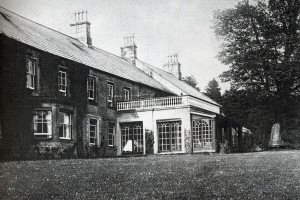 The
Hall at Wemmergill was the first property in the dale to have electricity, installed
in the summer of 1899 in readiness for the shooting season. The rest of the
dale had to wait more than fifty years for its supply.
The
Hall at Wemmergill was the first property in the dale to have electricity, installed
in the summer of 1899 in readiness for the shooting season. The rest of the
dale had to wait more than fifty years for its supply.
A new era has recently begun as the Wemmergill Moor Estate has changed hands in 2006 for the first time in almost 450 years. The new owner is Mr Michael Cannon, There are two additional gamekeepers employed and they have brought their families into the dale.
Education
Long before education became compulsory in the late 19th Century, schools existed in Lunedale. We know that a school existed at Caribeck in 1792 because a Miss Gibson of Thringarth left £20 to it in her will. The London Lead Company made grants to two schools in the Dale at Grains o'Beck and Carlbeck. There was a Dames school at Laithkirk in 1851 where basic reading and writing was taught and for an extra 8/- arithmetic tuition was available. The regulations were made and signed by order of the Parsonage of Laithkirk.
We believe the current school was built at Carlbeck in the 1850s and enlarged in 1885 and 1895, the monies being raised by the people of Lunedale. Records show that the Earl of Strathmore, Sir Fredrick Milburn MP, the dale's people and pupils gave donations for its upkeep and it was receiving grant money from the Government in 1885. in 1902, when the newly formed North Riding Education Committee took over the running of it, sixty-six children were registered and in the previous decade there is anecdotal evidence of seventy-two pupils. The school finally closed in 1958 with only eleven pupils on roll.
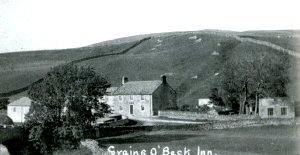 The
buiidinq then served as a Community Centre for a number of years, however, not
only was the population of the dale still in decline but also people's expectations
were changing and they were able to travel further afield. The Barnard Castle
branch of the YMCA converted the building into an outdoor centre in the 1970s.
The
buiidinq then served as a Community Centre for a number of years, however, not
only was the population of the dale still in decline but also people's expectations
were changing and they were able to travel further afield. The Barnard Castle
branch of the YMCA converted the building into an outdoor centre in the 1970s.
After the YMCA ceased to use it, staff from Longfield School, Darlington leased it for the same purpose until the late 1990s. after which it fell into disuse.
Leadmines, ore and minerals
There are many signs of early bell pits and hushes on the moors and a very early smelt mill at Wemmergill. At Lunehead there are old mine shop buildings where the lead miners stayed during their weekly shifts. The London Lead Company leased the mine for most of the 19th century and made grants to both schools in the Dale at Grains o'Beck and Carlbeck and towards major road improvements in the 1830s. Until early in the twentyfirst century there was a barytes mine at Close House that had existed for very many years.
Read more about the geology of Lunedale.
Quarries
Quarrying has been a feature of Lunedale for many centuries varying in scale and age. Their partially weathered outcrops and spoil heaps are found throughout the dale. Whinstone, limestone and freestone have been quarried for local buildings and walls: and roads and smelt furnaces further afield. Thringarth and Green Gates quarries closed early in the twentieth century. Setset quarry closed most recently in January 2006.
The carriage road
An act for making and keeping in repair a carriage road from Brough under Stainmore to Middleton bridge with a branch from Chapel House to Eggleston Bridge was given Royal assent 16th June 1817. The road was built by the turnpike trust to improve trans-Pennine communications and for increasing the productivity of the mines, as the ore by this time had to be taken to Blackton, Eggleston for smelting. The London Lead Company made grants towards these road improvements as they leased the lead mines and wanted to transport more lead ore more quickly.
The tolls
- For every horse drawing any coach, chariot, landau, beriin, chaise.cumcule. calash.ed cart, hearse or litter the sum of ninepence.
- For every horse, mule or ass laden or not laden, and not drawing, the sum of 2d (old pence pre decimalisation).
- For every drove of oxen. cows or neat cattle the sum of one shilling and three pence per score and so in proportion for a greater or lesser number.
- For every drove of calves, hogs, swine, goats, sheep or lambs the sum of seven pence halfpenny per score and so in proportion for a greater or lesser number.
- Carts charged in proportion to their wheel widths- 9"=4d, 6"=5d, 4"=7d, 3"=8d 21/2" or less is double the amount charged.
- Gates swinging out onto the road forfeit and pay any sum not exceeding 20/-
- Nuisances on the carriageway - timber, stones, manure etc., slaughtering, shoeing horses or playing football or other games every person offending shall pay a sum not exceeding £5.0.0.d
- Footpaths to be made as the trustees think fit. The penalty for driving or carts along these shall not exceed 20/-
19th and 20th Century migration and depopulation
The population of Lunedale increased steadily during the 19th century until it peaked at 400 as shown in the census of 1871. However, during the late 19th Century farming, forestry, quarrying and lead mining, the traditional employments, began to decline. Men and women left Lunedale to try to improve their lot. Several families went to North America; to Wisconsin to the lead mines, to Ontario to farm and to Nevada to the gold rush towns. Others left the dale to find work nearer to hand in the coalfields of Durham and for the railway companies.
The building of the two reservoirs, Grassholme and Selset, destroyed some of the most productive land and at least eight farmsteads in Lunedale as well as others on the other side of the river Lune in Kelton. The meadows and the farmsteads were drowned and many people were forced through compulsory purchase to move away from the Dale as their livelihoods were removed.
Grassholme reservoir was built in the early years of the last century, and a higher and longer bridge built to span the drowned flood plain. In times of low rainfall,when Grassholrne reservoir is very depleted, every twenty years of so, the old Packhorse Bridge over the original channel of the River Lune re-emerges. There was a mill near this point, which was also drowned following the construction of Grassholme dam. Read more about Grassholme
Selset reservoir was built in the latter half of the 1950s to provide water for the growing demand in the lower Tees Valley. Seven farms were drowned under this construction and several others became non-viable. There was no discernible advantage gained by Lunedale, it may have hastened the arrival of electricity by a year or so but the resultant depopulation was the final nail in the school's coffin. Read more about Selset
The direct result was that eight families left the dale and consequently there were fewer work opportunities for labourers and people in service. Throughout the 20th Century mechanisation and social change also reduced the need for large numbers of labourers.
The dale gradually lost all of its facilities; the post office, inn, chapel and school at Grains o'Beck; the inns and school and eventually the chapels lower down the valley. The weekly Wednesday bus service to Barnard Castle also ceased.
Lunedale used to have at least four inns. Grains o'Beck, (closed 1935), Pool House, (closed 1934 but operated as a Youth Hostel until the Second World War) and Chapel House, where the inscription can still be read 'Good Ales, tobacco and pipes. If by you go and dry you be the fault's in you and not in me'.
Lane Head (Road Head) was also a licensed premises as shown in the 1841 census when Christopher Alderson was named as the innkeeper.
Carlbeck School closed in 1958 with only eleven pupils on roll whereas in 1902, when the newly formed North Riding Education Committee had taken it over, there were sixty-six pupils registered. In the previous decade there is anecdotal evidence of seventy-two pupils attending.
Revival and Regeneration
The 1970s were the turning point of the decline in the dale's population. Agriculture became more profitable and properties were modernised and some farmers' wives supplemented family income by offering Bed & Breakfast accommodation. Diversification became the buzzword.
Lunedale has always been a trans-Pennine route to Scotland and the Lake District and the eariy development of Bed and Breakfast began with Inns, which were stopping off places for commercial travellers rather than tourists. Lunedale's inns have closed and now the tourists come to enjoy the area itself.
The Pennine Way traverses Lunedale and is extremely popular with walkers and hikers. In 2005 large areas of moorland have been designated open access under the Right to Roam Act-improvements in reliability and availability of private transport have made travelling to work at Barnard Castle and beyond more viable and now many people in Lunedale have careers totally unrelated to traditional occupations. They chose to live here because the dale offers them a better quality of life than that found in neighbouring towns. This has benefited the community by bringing new people, ideas and experiences.
Young families have moved into the dale, the number of gamekeepers has increased and local businesses now include not only farming but also a bakery, saddler, caravan-park, smokehouse, holiday cottage, and bed and breakfast.
